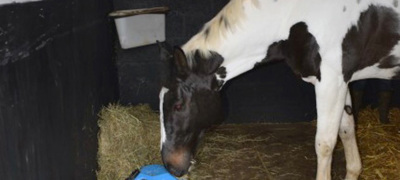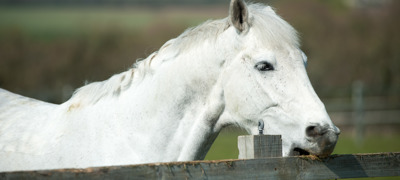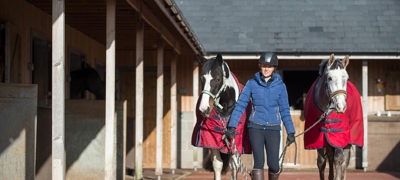Wild horses learn from their elders and thrive with other horses around them. Although this exact dynamic can be difficult to replicate in domestic horses, there are many ways you can provide the social interactions and companionship they desire.
Daily care and fun!
Horses will commonly form pair bonds which can last a lifetime. This bond will provide mutual protection (one can be the lookout while the other sleeps), body care (standing head to tail to swish away flies) and strong friendships through play and mutual grooming. Play is also commonly seen in herds, especially within young horses and helps to develop their social skills, musculoskeletal system5 (which later helps them cope better with their initial training6) and place within the group.
The modern-day management of horses can disturb these bonds and, if not appropriately managed, can potentially cause separation anxiety. During their lifetime, horses may move yards or travel for competition and are commonly stabled and exercised individually. Being aware of your horse’s behavioural needs and learning to recognise when your horse is becoming stressed, anxious or fearful is crucial in supporting their mental wellbeing. It is important to minimise any effects of separation anxiety and explore ways that you can continue to meet their social needs. If your horse has separation anxiety and you need support, the Animal Behaviour and Training Council has a list of qualified professionals.
The need for companionship
Horses are housed in different systems which provide varying amounts of social interaction (from full to none) and companionship, resulting in a greater variety of behaviours, some showing frustration and stress.
Both long and short-term social isolation can have a negative impact on horse welfare, as horses are highly motivated to seek social interaction7. Therefore, not allowing horses to interact or see other horses, along with some management factors, may all contribute to the development of stereotypical behaviours which are rarely observed in the wild7. However, the individual horse’s coping style will also affect how they respond to stress.
Meeting your horse’s social needs
Group Housing
chevron-down
chevron-up
Keeping horses in groups has many positive benefits, helps to prevent stress and decreases the chance of stereotypical behaviours developing8. A reduction in stress can also limit a build-up of gastric acid in the stomach, decreasing the risk of gastric ulcers and enhancing digestive health9.
If you are introducing your horse to a new herd, turn them out in an empty neighbouring field if facilities allow, making sure fencing is safe and secure. This will help to avoid conflict, preventing stress from bullying and allows all horses to get used to each other safely. Space is also an important consideration as the more space available reduces the risk of conflict and injury.
Grooming
chevron-down
chevron-up
Mutual grooming is one of the most common social activities in horses. The wither area is often a preferred spot! By taking the time to give your horse a good groom you can begin to mimic this social interaction while also:
- Improving the human – horse bond
- Lowering the horse’s heart rate4
- Increasing blood flow to the skin’s surface
- Promoting a healthy coat
- Massaging large muscle groups
- Checking for any lumps and bumps
Mirrors
chevron-down
chevron-up
Stable mirrors can benefit horses suffering with separation anxiety and helps to reduce the chance of stereotypical behaviours developing7.
When introducing mirrors, allow time for your horse to accept and benefit from it. Make sure the mirror is positioned so the horse has a choice whether to look at their reflection or not. Be wary of installing mirrors along the whole length of a wall, or close to a horse’s eating area as this can cause more stress and anxiety, or aggression and protectiveness of their food.
Always use safe materials such as acrylic plastic and monitor how your horse reacts, removing the mirror if they show constant aggression or are becoming distressed.
Buddy System
chevron-down
chevron-up
If individual turnout is your only option, make sure other horses are always visible and, when stabling, avoid leaving horses alone in the stable block. Operating a buddy system whereby field companions come in together can be a simple solution. Some yards will operate a buddy system for horses on box-rest, where companions are used in a rota to be stabled next door to help provide company.
Provide Stable Enrichment
chevron-down
chevron-up
Using enrichment provides a greater variety and choice, while positively contributing towards your horse’s physical and mental needs. Before providing new enrichment options for your horse.
Note – when using certain types of enrichment activities, as shown in the image, supervision is advised.
What if my horse has to be isolated or is on box rest?
There may be circumstances where your horse has to be placed in isolation (due to disease prevention) or immediate box rest 24/7 on veterinary advice. Although this may hinder social interaction and create a short-term stressor, it's important to focus on the long-term benefits. Where applicable, implement the above advice to help support your horse during this time.
Donkeys
chevron-down
chevron-up
Donkeys form extremely strong and long-lasting bonds and if separated can experience severe distress in the form of pining behaviour and loss of appetite. Learn more about donkey behaviour and the importance of companionship.
References
chevron-down
chevron-up
- Busby, D. Social Structure of The Horse. Association of Pet Behaviour Counsellors.
- K Overall, MSD and the MSD Veterinary Manual https://www.msdvetmanual.com/horse-owners/behavior-of-horses/normal-social-behavior-in-horses
- Hastie, P, S. The British Horse Society Veterinary Manual. Second Edition. Kenilworth Press of Quiller Publishing Ltd. (2018). P.19
- Feh, C., de Mazieres, J., 1993. Grooming at a preferred site reduces heart rate in horses. Animal Behaviour. 46 (6), 1191–1194.
- Cameron, E.Z., et al, 2008. Maternal investment results in better foal condition through increased play behaviour in horses. Animal Behaviour, 76(5), pp.1511-1518.
- Søndergaard, E., Ladewig, J., 2004. Group housing exerts a positive effect on the behaviour of young horses during training. Applied Animal Behaviour Science. 87, 105–118
- Søndergaard, E., et al, 2011. Motivation for social contact in horses measured by operant conditioning. Applied Animal Behaviour Science, 132(3), pp.131-137.
- McGreevy, P.D., et al, 1995. Management factors associated with stereotypic and redirected behaviour in the thoroughbred horse. Equine Veterinary Journal. 27(2), 86-91.
- McGreevy, P. (2012). Equine Behavior - E-Book: A Guide for Veterinarians and Equine Scientists. Saunders. Elsevier.







Social behaviour – the herd structure
Horses are social animals regardless of whether they are wild or domesticated. Wild horses live in herds which provide much needed companionship, security and social behaviour. This is needed to help reduce conflict and enhance herd stability1. Herd stability is vital in terms of survival, for example, one horse keeps watch while the others rest. Below you can see the structure of a wild horse herd, some of which may seem familiar with your own horses.